The art of the abandoned cart email: How to bring customers back and save the sale
| January 29, 2021
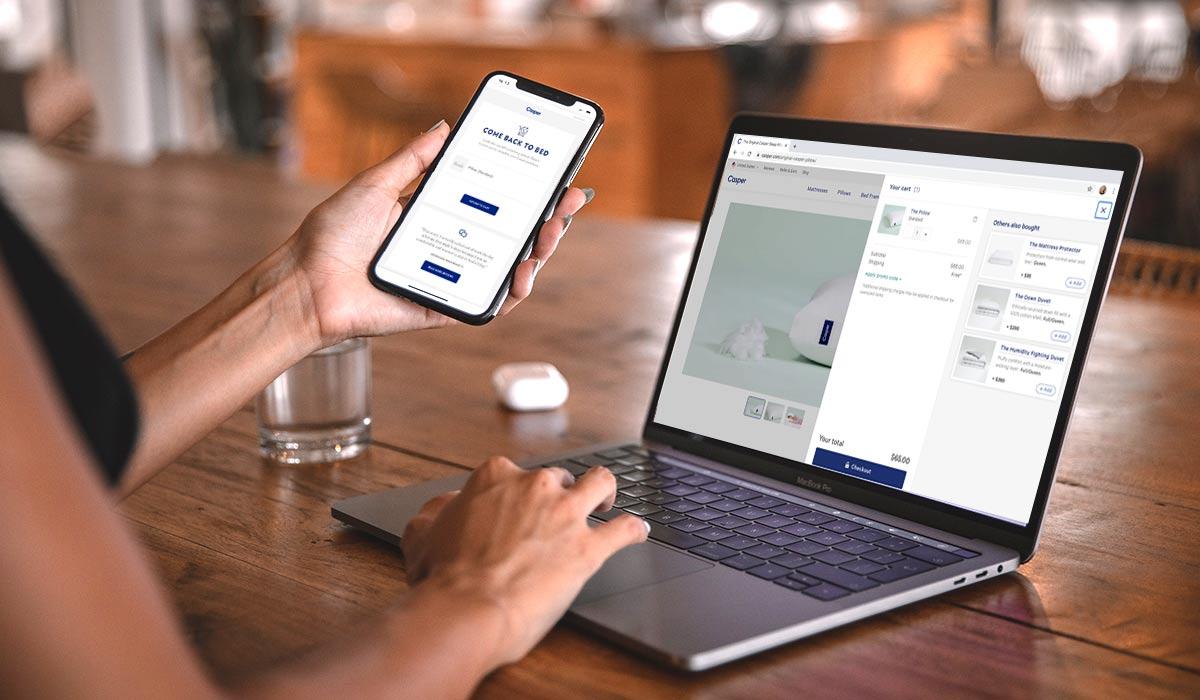
Last weekend, I was shopping online for a rain jacket for an upcoming hiking trip. After hours of searching and reading reviews, I found the perfect one and put it in my cart. But when I went to check out, I hesitated. Maybe there was an even better option out there.
I decided to put the decision off for another day and closed the window. In e-commerce terms, I abandoned my cart.
Will I ever buy that jacket? Maybe. But as things stand now, an outdoor brand was very, very close to a sale, but didn’t quite get me over the line.
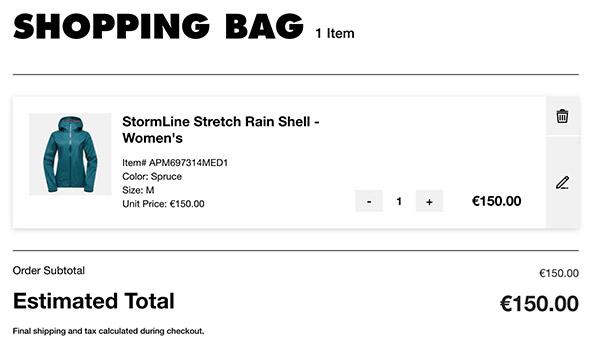
I’m not alone. E-commerce giant Shopify estimates that 60-80% of shopping carts are abandoned. You read right: 80%. A vast majority of shoppers who put items in their carts never buy them.
Fortunately, there’s a highly effective way for companies to get a good chunk of that revenue back: the abandoned cart email.
In this article, I’ll explain why abandoned cart emails work so well and highlight best practices for writing your own, with fantastic examples from brands that got it right.
What is an abandoned cart email?
An abandoned cart email is a type of automated marketing email. These customized emails are triggered when customers put items in their cart, but don’t complete the check-out process. Abandoned cart emails have high conversion rates, making them one of the highest ROI marketing emails.
Why send abandoned cart emails?
Abandoned cart emails are one of the most effective types of email marketing. It’s easy to understand why. Someone with an abandoned cart has already:
- Discovered your brand
- Developed an interest in your products
- Visited your website
- Stayed on the website
- Picked out at least one product
- Completed the first step to making a purchase
That’s a lot of hurdles already cleared. They know your brand. They’re interested in your products. They’re at least considering making a purchase. Leads don’t get any better than that.
People with abandoned carts just need a one last nudge. They’ve even told you exactly which products they were this close to buying. That makes it easy to create customized, automated emails that highlight exactly the products they find most appealing.
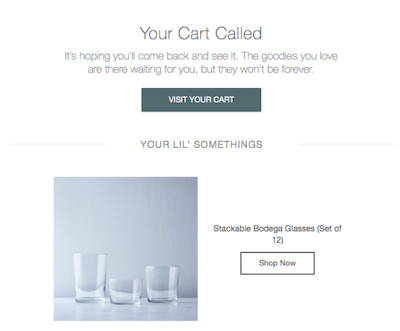
Taking all that into consideration, it’s hardly surprising that automated emails convert like crazy.
One email marketing platform reports that abandoned cart emails usually have a click-through rate around 21%. That’s almost 10 times the average email click-through rate of 2.6%. And it gets even better: A staggering 50% of those clicks result in a sale.
Examples and advice: What makes a good abandoned cart email?
Just because people with abandoned carts are on the verge of making a purchase, doesn’t mean any old email will be enough to convince them. After all, a customer with an abandoned cart is still making up their mind. This moment calls for your best messaging and top-notch copy.
So what boxes do you need to check? Here are a few tips and tricks to make sure your abandoned cart emails are up to scratch.
Understand why people abandon carts
The first step to writing a great abandoned cart email is understanding why people abandon their carts in the first place.
Some of the top reasons are:
Sticker shock – According to research by Shopify, the #1 reason for abandoned carts is sticker shock at check-out. Often this happens because of the cost of tax, shipping or extra processing fees. Or people put several items in their cart and didn’t realize how much they’d add up until they saw the total.
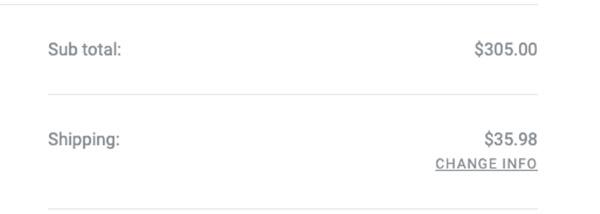
They’ve changed their mind – Even when the total at the bottom of the shopping cart doesn’t come as a surprise, it can still give shoppers pause. As they start checking out, people might remember that vacation they’re saving up for and decide they don’t really need a new pair of shoes or yet another houseplant.
They’re still deciding – They’re still considering a purchase, but they haven’t completely made up their mind yet. This type of shopper is likely still in the research phase. Or they may be wary of impulsive purchases, and waiting to see if they still want the item in a few days.
The wishlist effect – Just as people ‘window shop’ on the street, they sometimes browse e-shops with no intention of buying. Maybe they’re fantasizing about a future purchase they’re still saving up for, or putting together a list of items they’d buy if money were no object. Many online shops offer a wishlist feature for this type of ‘shopping,’ but plenty of people still use their carts instead.
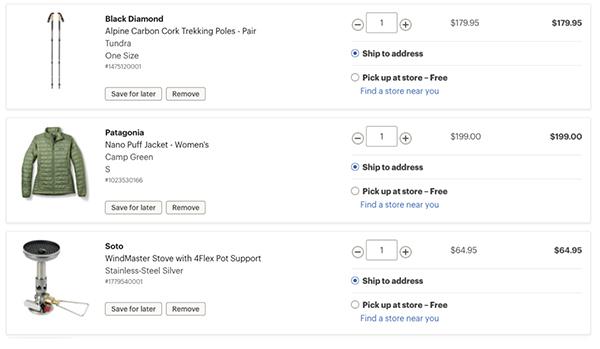
Notice one reason that’s not on this list: forgetfulness. People don’t usually abandon their carts by mistake, so I find it perplexing that so many brands write ‘You forgot something!’ in their abandoned cart emails.
As you’re writing your email, steer clear of this alienating cliche, and keep the real reasons people abandon their carts in mind instead.
Put the product front and center
One of the great things about email marketing is how easy email is to customize, and abandoned cart emails are the perfect opportunity.
When customers put an item in their cart, they’re giving you valuable information about exactly which product they find most appealing. Don’t just remind customers they’ve got something in their cart. Show them exactly what’s waiting for them – the more stunning the photos, the better.
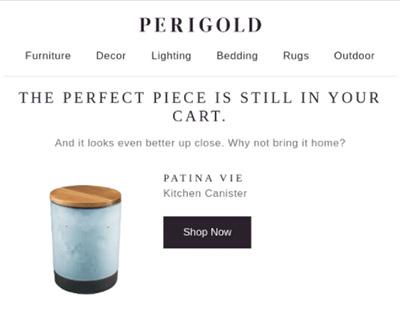
Stay positive
It’s all too easy for abandoned cart emails to slip into a negative tone. ‘Oops, you forgot something’ isn’t the only offender. I’ve seen abandoned cart emails that profess hurt feelings or state that surely your WiFi crashed (Why else would you possibly abandon your cart?!).
Whether written in humor or as a genuine attempt to guilt customers into completing a purchase, negative copy ruins the mood and will put customers off. Instead, keep things light and positive. Enthusiasm for your brand and excitement about your products is the most effective way to draw customers back in.
This email from Everlane is the perfect example:
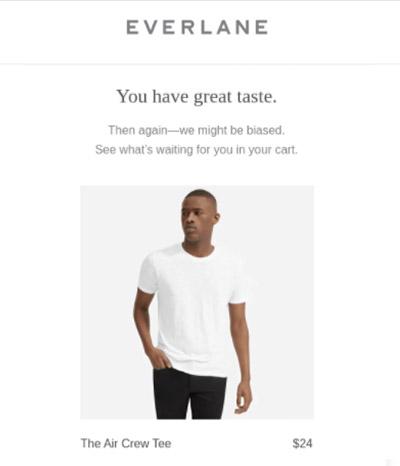
‘You’ve got great taste’ is fantastic, straightforward copy. It flatters the customer while also placing the product in a good light. Most importantly, it draws people back to their carts without a hint of whininess or desperation.
Paint a vivid picture
One way to reignite customers’ excitement for items left in their cart is to help them imagine what it would be like to own the products they’ve left behind.
This example from J. Crew asks shoppers to picture the items they’re lusting over hanging in their closet:
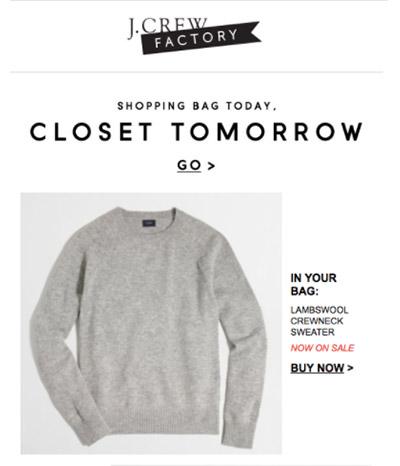
Lego takes a similar approach with the line ‘Make it yours in a snap!’ This clever choice of words taps into customers’ emotional connection to the product. It calls up tactile memories of playing with Legos, making it easy for shoppers to picture themselves assembling the set they’re thinking of buying.
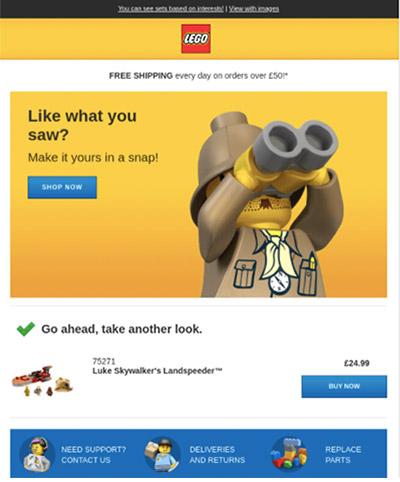
Highlight key selling points
With customers right on the verge of making a decision, an abandoned cart email is a great time to roll out the big guns and highlight the most convincing selling points for your products. You can list them yourself, or rely on social proof in the form of customer quotes and outside reviews.
That’s what mattress company Casper does in their abandoned cart email:
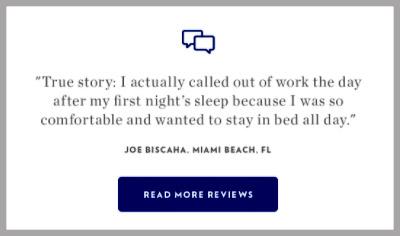
This excerpt actually comes from my favorite abandoned cart email, which I love for a totally different reason: the headline ‘Come back to bed.’ Now that’s some genius email copy!
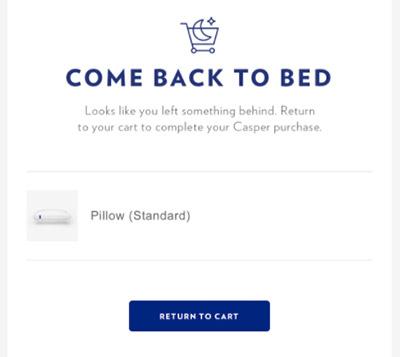
Sweeten the deal
If you want to be extra convincing in your abandoned cart email, consider a little extra incentive. Free shipping or a discount code could be just the thing to convince people who abandoned their carts due to price concerns to reconsider.
A twist on this idea is an abandoned cart email triggered not when the shopper abandons their cart, but when the items in their cart go on sale:
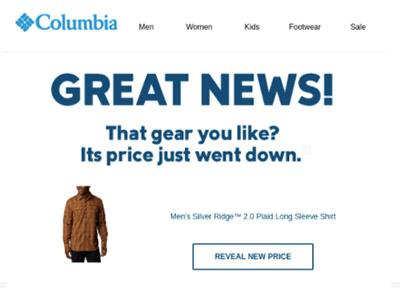
Create a sense of urgency (or security)
A common tactic in abandoned cart emails is fostering a sense of urgency. If the desired item might sell out, the customer is motivated to act now. This has roots in basic psychology. Not only is there logistical time pressure, but scarce items inherently seem more valuable.
Here’s an email from the Google Store that puts this strategy into action:
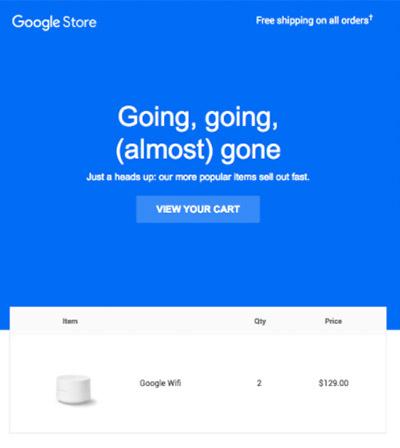
However, the urgency approach isn’t universal. Other brands go in the complete opposite direction, telling customers their items are saved for them in their cart. This fosters a feeling of ownership of the abandoned product and projects an image of great customer service.
Here’s an example:
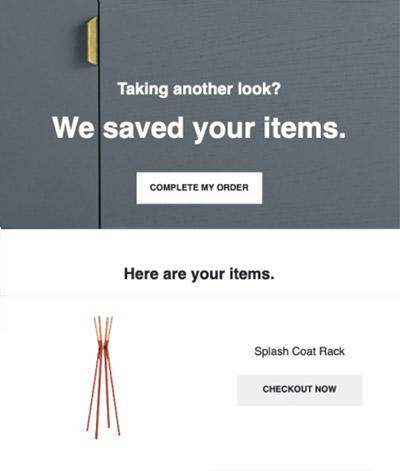
How should you decide which method to use? It’s easy: whichever applies. If you really might sell out, give customers a heads up, so they can get it while they can. If not, simply let your customers know that when they’re ready to pull the trigger, that cool coat rack will be waiting for them.
Make abandoned cart emails work for your brand
Abandoned cart emails are a valuable (and underutilized) type of marketing email. Not only do they convert insanely well, they also take advantage of some of the biggest benefits of email marketing, like customization and precision timing.
This provides a positive, personalized experience, meaning you benefit twice: immediately with a sale, and long-term from the customer loyalty that comes from a stronger relationship with your brand.
Because they rely on advanced features like email automation and custom content fields, abandoned cart emails can seem intimidating at first. But chances are, the email service provider and e-commerce tools you already use offer features that make it easy to set them up. And with double-digit conversion rates, doing so is well worth the effort.
So let the examples above inspire you, get your creative juices flowing and go write some killer abandoned cart emails of your own.
